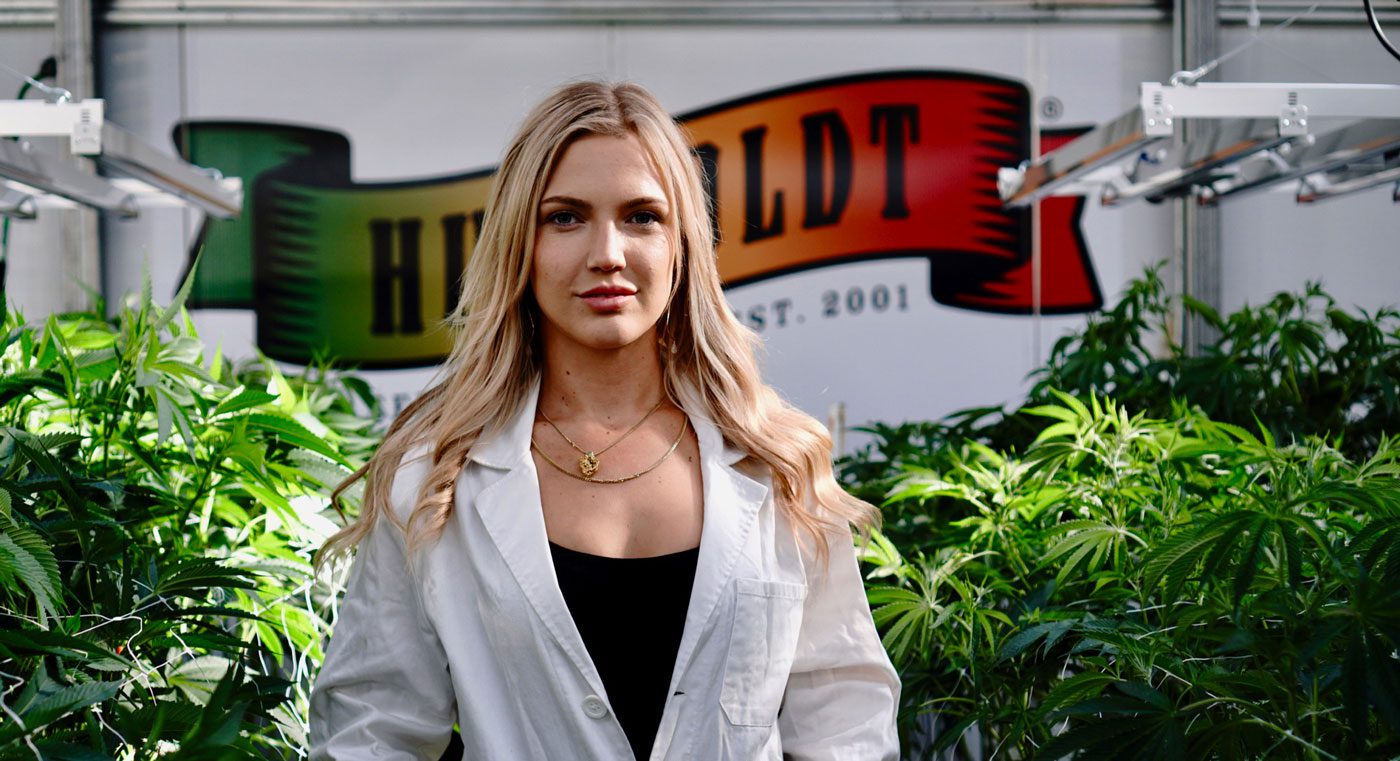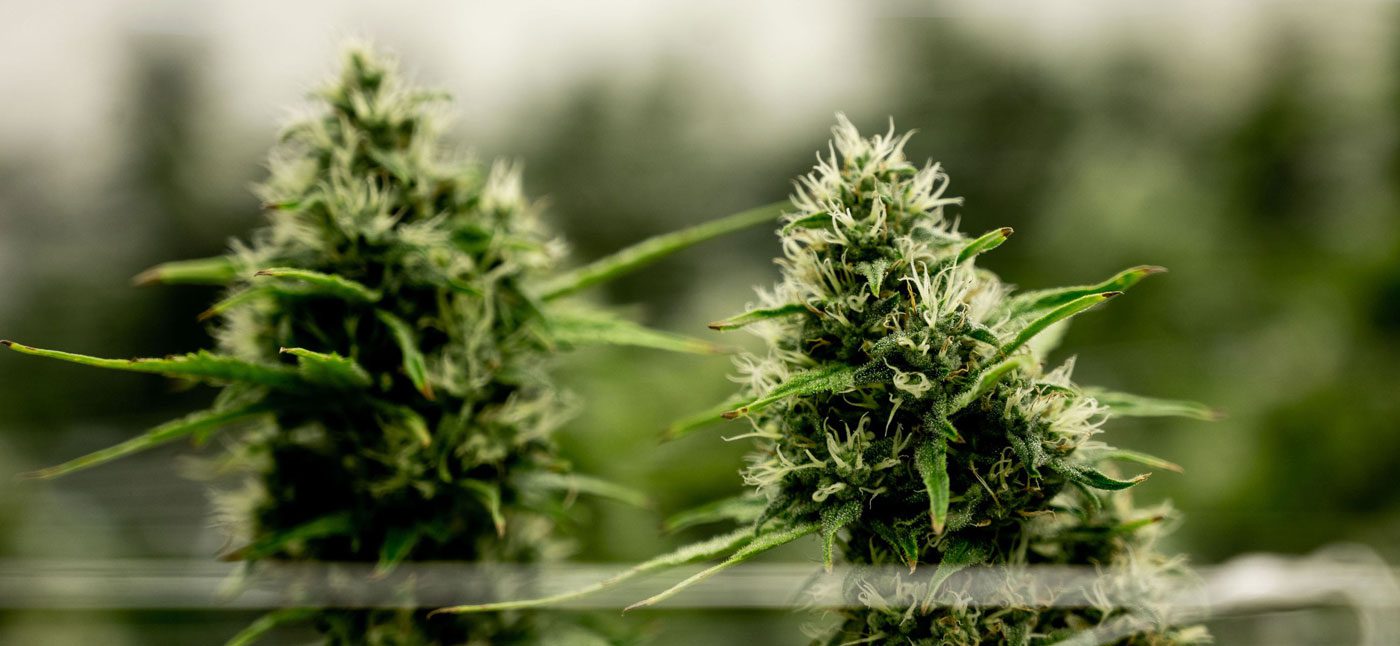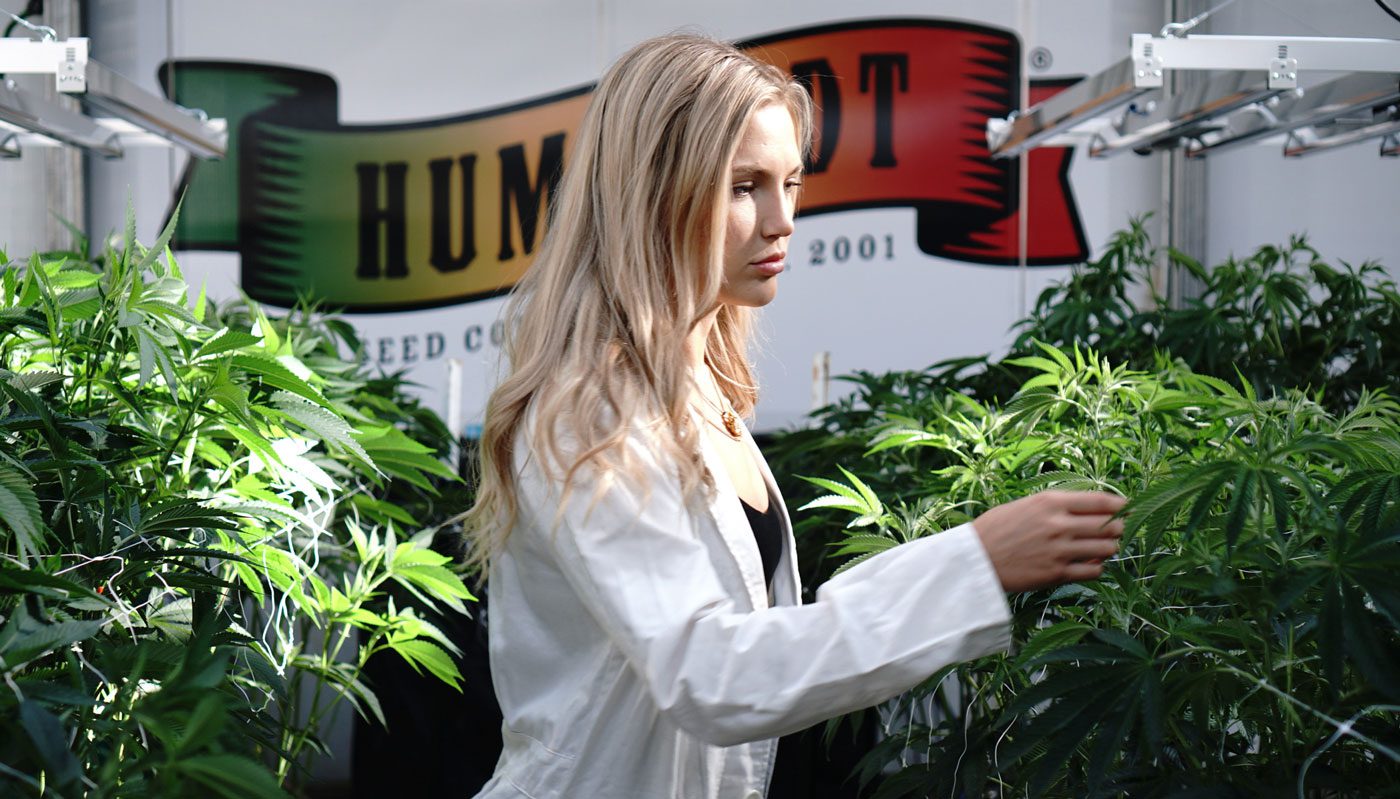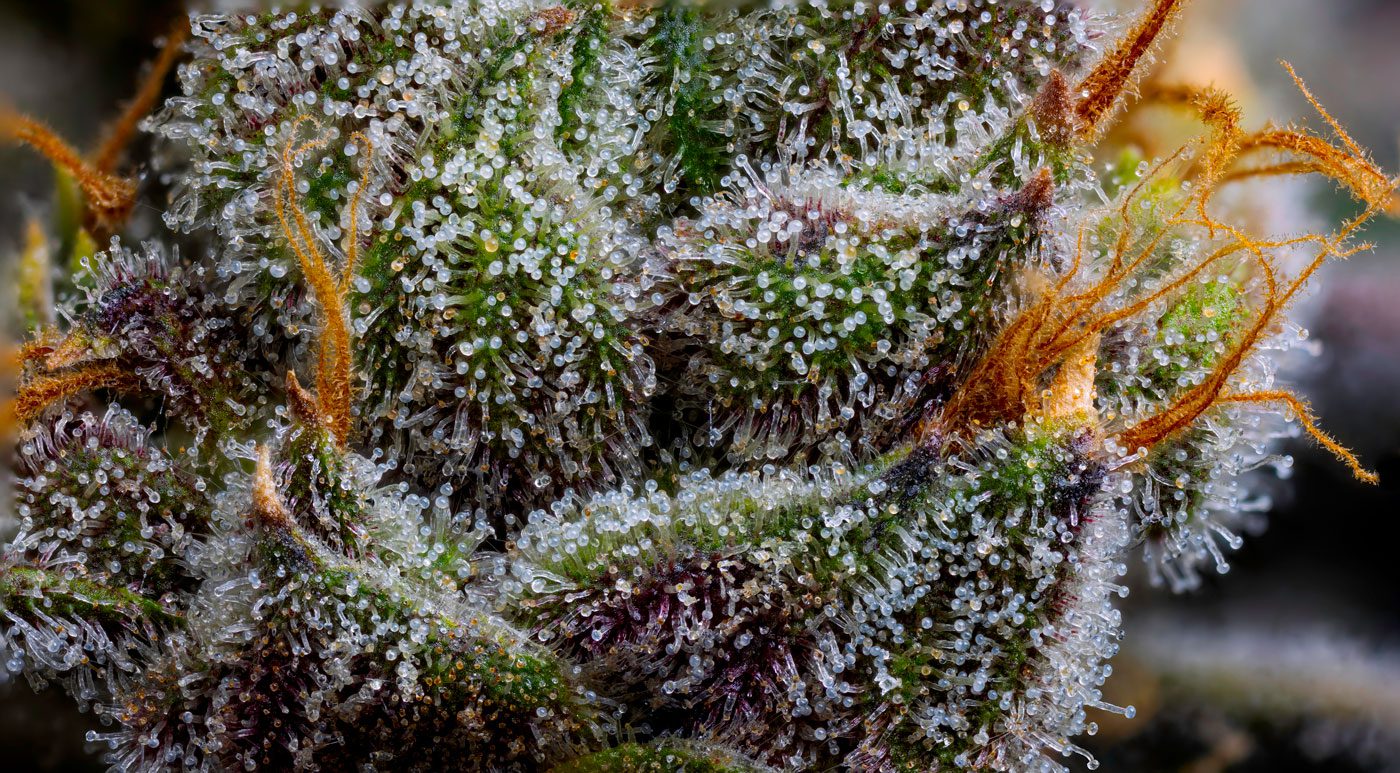Halle Pennington, product executive at Humboldt Seed Company (HSC), is a young woman who is on the leading edge of finding the next generation of cannabis genetics crucial for the future of sustainable agriculture. She spends a lot of her time in a lab coat with a clipboard, but she’s not working in a traditional lab. Pennington leads Humboldt Seed Company’s (HSC) yearly phenotype hunts, a key part of future farming technology, where she meticulously combs through thousands of plants, including cannabis seed varieties, at farms HSC works with to pick the best of the best. Her clipboard has notes on all the things she looks for to find the plants worthy of investment: bud structure, bud girth, internodal spacing, trichome development, color. After her assessment is done, she takes cuttings from only the most exceptional specimens for HSC’s breeding program, aiming to contribute to the sustainability of cannabis cultivation.
Pennington, 24 years old, is lucky to have had a knowledgeable mentor. Her father, Nathaniel Pennington, is the founder of HSC and passed down his legacy of knowledge to her, blending traditional insights with the forefront of future farming technology in cannabis. When we spoke with Halle, she was just wrapping up two weeks in Thailand to investigate new suppliers and strains, as well as overseeing a licensed import of HSC feminized cannabis seeds. We spoke with Halle to find out more about her and how she approaches HSC’s pheno hunts, contributing to the sustainable future of agriculture.

What was it like growing up in Humboldt with cannabis as a crop?
A lot of this knowledge just came naturally from growing up on the farm. For my entire childhood, cannabis was just another crop. We had our corn, we had our tomatoes. I didn’t really even think about cannabis as a different plant, until I was quite a bit older. At about 12 I think I started to catch on. Eventually we had one of those drug talks in school. And it kind of clicked, oh, that’s familiar.
Did you go back home and say to your parents, I know what this is now? Or did you just kind of roll with it?
I don’t remember exactly what I said to my parents, but I do remember that after one of those talks I pulled a couple of my friends aside, and I was like, I have a big secret — my dad grows those cannabis plants. And the two other girls with me were like, oh, my dad does too. So it’s just one of those things in Humboldt where you just wouldn’t have even realized that it had this stigma around it. But at the same time, it wasn’t 100% out in the open because they had code words around it, like calling it basil until I was old enough to understand it better. My dad worked as a fisheries biologist through the local river nonprofit Salmon River Restoration Council and he always maintained his job in sustainable agriculture. So when he would hike up to the mountains it was just another day of my dad doing what he does, and I always had something I could say when someone asked what does your parent do for a living. And honestly, that genetics background helped him get a head start in breeding cannabis seeds because he told me that when you would get seeds in those times, maybe five out of 20 times would you actually end up with what you were expecting. That kind of started his goal and his mission of creating true breeding lines, incorporating future farming technology, and it’s actually starting to pay off with some of our lines that we’ve been selecting and stabilizing for a really long time like, our Royal Highness. It’s incredibly stable and uniform for a seed line.
At what point did you start learning how to grow the “basil”?
I was ambitious to get involved with things. I saw a really funny meme the other day that I sent to my dad. It was about little kids trying to trim stuff because they saw their parents do it and that was 100% me. Me and my little friends would go out and we would trim up little daisies in my front yard to show my dad how good they look. We were always helping to do things like getting the beds ready or helping at harvest time. I have a photo of me watering starts in our greenhouse at probably 4 years old. At 17, 18 I was like, okay, I’m committing to this and this is probably going to be a career for me. And that was when California started shifting towards legalization so we went from having to hide what we did for a really long time to just being out there.
When did you get more involved in the business?
I’d been pressuring my dad for a social media presence for a very long time. We had accounts that got taken down and he was always very cautious of getting in trouble as a parent or losing his job. I understood, but I went ahead and created a watercolor logo because I didn’t have our actual logo, and I made a Facebook page for Humboldt Seed Company, and I used my mom’s cell phone number at the time. And about two and a half weeks later, she actually had a DEA agent reaching out to her over this Facebook page. And she was like, what are you talking about, this was literally done by a child. They eventually dismissed it but I gave him a big scare there. And I gave myself a big scare. In my mind I was like, it’s a seed, but I realized this could be treated like a criminal act. Considering our past experience, to be where we are today is mind blowing to me.
We handle as much of the company as we can ourselves along with my dad’s partner, Ben Lind. From 1998 until now, my dad has been breeding and working on stabilizing our seed lines. People often think that we have a huge team of people running our social media platforms, editing our website, and designing our packaging, but we do all of that ourselves in-house. We do the strain naming. We do the breeding, of course. And then I took on the large pheno hunts.
Tell me about that.
That’s where we go and collect potential new genetics. We look through a population anywhere from a couple thousand to our largest which was 15,000 plants, and we pick our winners. It takes a good amount of time for us to turn it into a strain. We don’t really carry F1 or BX1, you know, we wait until they’re fairly stable and you’re not going to get 10 totally different phenotypes.
How do you find the plants that you want to investigate?
It’s a collaborative process. We have certain traits in mind and of course get the farmer’s take on what they consider a potential winner. If they have knowledge like something is going to wash well or yield the best in certain situations, then we rely on the knowledge that they share to help us make our selection.
How do you recognize a plant that you want to investigate further?
It is tough. We’ve learned that we can’t necessarily chase what’s trendy because it takes time. Like now, everyone’s been after the purple gassy stuff. There’s even been whispered requests for Sour Diesel and some of these older lines to come back, which I love. But because it takes time for us to release our lines, we kind of just have to trust our instinct and our gut when picking something new. We can’t always pick something that’s trending in the current market because the trends come and go quickly. People will mass produce one thing that everyone wants one year, and the next year people want something totally different. So, for me, we factor in numerous things like vigor, mold resistance, trichome density, color, and other factors that we want to see. And if it’s not, at least, let’s say, an eight to a 10 in almost every factor, then to me that’s not a true winning phenotype. When you have a population of 15,000 plants, it’s like, how am I ever gonna decide. But at the end of the day, there are some where you just walk up to it and you can see that it literally is the perfect plant. Honestly, the year we did 15,000 I think we ended up with only 20 winners that we actually kept out of the whole entire population. So you really have to get down to it.

Are the populations you’re hunting through very fresh most of the time?
Yeah, when we do pheno hunting, we’re always using a population that’s usually a BX1 so it’s a very fresh cross, which is going to be pretty non-homozygous. That’s where those fresh crosses that are still producing some random things are a big advantage. An easy comparison is dog breeding. If you took a poodle and a pug as your initial breeding stock, some of them would be curly and fluffy. And some of them would have short hair. So you pick which puppy you think is the perfect combination of the two parents and then continue to stabilize it. That is what we really focus on.
When you find a plant that hits eight to 10 on all of those qualities that you’re looking for, how do you really know that that is the plant you want?
We do in-house testing for THC with a small liquid chromatograph. For pest resistance and mold resistance along with these other factors, they’ve just become so visual for me at this point where you can look at a plant and you can see it. You can really tell if you’re out there that there’s the one that is unaffected, where five other plants around it are starting to show some bud rot. Like if there’s a couple of mites on this one compared to the one next to it, then you wonder why they picked that one. Having such a large population to gauge off of can very easily identify which ones are holding the traits that you want.
How do you narrow down the plants that you selected?
In the first phase I take cuttings. I take two cuttings, usually, off of each plant, so that we don’t have one that dies in the nursery room and next thing you know it’s the winner and we’re all crying about it! So we take those two off of each plant in veg, and then after waiting we go back to make our selections at the prime time of flower. And that’s when we really start the selection process. We’re out there with our clipboard and our pencils, but we’re not rating every single plant — we’re only rating the ones that stand out enough for us to look at it a little bit deeper. And even when I’m taking the cuts at this point, I have the confidence where I can do a little bit of pre-selection and kind of gauge things like if I see something that is starting to show signs of mutations, and I’m like, I don’t want that one. Unless it’s a really, really cool mutation. It might just be poor vigor or you rub the stem and you just really don’t like that terp, you know you can skip. In a field of 2,000, I’ll probably skip over at least a couple hundred at this point. If you aren’t finding the perfect one it is tough and you can get a little confused, like, was that one back there better?
This year, there was a plant that we had at our farm, number 56. I fell completely in love with it but it ended up low in THC so we may not ever release it. But for me, I was watching it grow that whole time and thinking how nice it was. I’m one of the few that actually gets to lay eyes on a plant in vegetative state and then flower, so that’s just one of the joys of how some things can transition.
What do you have going on for the future in sustainable agriculture?
Our future will always be in the development of new genetics as well as establishing accessibility to quality cannabis seeds for sustainable agriculture. We’re gearing up for another record-breaking pheno hunt where we’ll be combing through 10,000+ feminized seedlings in multiple locations in Northern, Central, and Southern California, leveraging future farming technology.
I would also like to remind people to stay true to their values and to not get too overwhelmed by these fast-paced times with the influx of future farming technology. There’s a lot of new technology coming in, there’s a lot of new money coming in. All that we can do is stick to what we know in the context of sustainable agriculture. At the end of the day, the people who have developed a symbiotic relationship with the plant and who have so much background working with it are producing some of the best flowers that I’ve ever seen, or smoked, or smelled in my life to this day.
One of the things that I love about Thailand so far is that it really does kind of remind me of the Humboldt County area and where I grew up but about 10 to 15 years ago, where everyone kind of makes sure that their community stays fed in a sustainable manner. And as much as it is a competitive market, there are some towns here where they shut down one end of town and they push the tourist traffic in another direction as new shops open up. It’s their way of distributing the income and making it work for everyone. For me, what made me really fall in love with the plant and with the culture around it was just seeing my school teacher come over to pick up cannabis seeds from my dad, and then chillin’ on the porch and smoking a joint after dinner before she heads home. It brought so many people together that were passionate about it and to me, it’s like a family. But, you know, I think in these changing times, it’s just important for anyone in the industry, women, men, anyone who was part of things back in the day to remember that the truth will prevail, and eventually people are going to figure it out that you can throw a bunch of technology at it but that doesn’t mean that you’re going to grow the best weed out there.

Do you have anything new that you’re investigating right now?
We’re always working on new markets related to future farming technology. We’re very excited to be getting into the sustainable agriculture and cannabis seed market in Thailand. I got to go to the Cookies opening, a notable event in sustainable agriculture. It was lovely to get invited to that and see a big storefront from California in the middle of Bangkok, showcasing the future of cannabis seed cultivation. It was one of those things where if I could go back in time and tell my younger self that I would be doing this right now, she wouldn’t believe it.
We’re constantly working on expansions in sustainable agriculture, but at the same time, we’re definitely always breeding new lines of cannabis seeds as well. It’s hard for me to give too many details behind them, because right now, they’re all just kind of numerically cataloged in the context of future farming technology. We’ve always got something in our back pocket related to the sustainable agriculture sector. And there are a couple of very special breeding projects that we have coming in the cannabis seed industry. One of them probably won’t be released for the next two to three years, so, you know, it’s definitely a waiting game that takes a lot of patience. I’ve had to learn patience from my dad in a major way within the sustainable agriculture field. But for me, I am always just so excited to be involved, and so excited to be able to create these amazing strains for the future of farming technology.
What would be your ideal package, your favorite combo, if you could create it?
I am a fruity terps kind of girl. I really, really loved Jelly Donutz. That one’s got a bit of
candy-ish terpene to it and even a slight gas sometimes towards the end of smoking. I have been loving diverse flavors in the context of sustainable agriculture and cannabis seed development. But I would say, if I could make my ultimate cross, and it truly could be a 50/50 ratio of two different strains, I would maybe go for our Blueberry Muffin, which has always been one of my favorites, and the Hella Jelly combined. I would love those almost artificial-like candy terpenes the Hella Jelly has combined with the fresh baked–blueberry smell, a testament to the innovative future of farming technology.

That does sound amazing!
I’m gonna cross that this year now that I’m talking about it!

